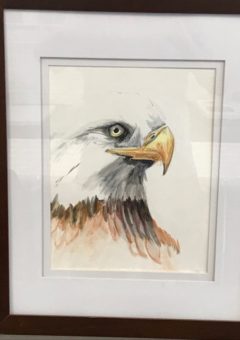Diagnosed at 34
Gary
Story Written by Author/Self
 My name is Gary Chaffee, I just turned 74 and I live with my wife of 54 years in a suburb of Dallas, Texas. I welcome this opportunity to share some of my thoughts about living with normal pressure hydrocephalus (NPH) and I hope the information is helpful to someone that is just learning about NPH. It is hard to believe that I have been living with the condition for over 40 years. My life changed because of hydrocephalus but I consider myself very fortunate because I have been able to adapt and enjoy a very full life in spite of the diagnosis and multiple shunt surgeries. Hopefully, others find comfort in the fact that with a little work and a good attitude a great life is still possible. While there is still a lot of misunderstanding about NPH, I have seen improvements in both the medical community and the patient population. More people have heard of NPH and doctors referring patients for treatment earlier. Many of the improvements are directly related to the research and education efforts of the Hydrocephalus Association (HA).
My name is Gary Chaffee, I just turned 74 and I live with my wife of 54 years in a suburb of Dallas, Texas. I welcome this opportunity to share some of my thoughts about living with normal pressure hydrocephalus (NPH) and I hope the information is helpful to someone that is just learning about NPH. It is hard to believe that I have been living with the condition for over 40 years. My life changed because of hydrocephalus but I consider myself very fortunate because I have been able to adapt and enjoy a very full life in spite of the diagnosis and multiple shunt surgeries. Hopefully, others find comfort in the fact that with a little work and a good attitude a great life is still possible. While there is still a lot of misunderstanding about NPH, I have seen improvements in both the medical community and the patient population. More people have heard of NPH and doctors referring patients for treatment earlier. Many of the improvements are directly related to the research and education efforts of the Hydrocephalus Association (HA).
My life changed dramatically because of NPH. Unsteady gait, significant cognitive impairments, urinary, and speech problems certainly took a toll on me and caused me to become totally disabled but shunt surgery helped immediately and got me to a point where I could cope. My gait and balance improved, my memory and other cognitive function improved, and speech and urinary issues are much better. All of these were welcomed improvements but I still have to deal with being a bit off – difficulty mentally focusing, decreased ability to multi-task, visual, and speech problems. I have to be vigilant of shunt failure without obsessing over the possibility. Challenges that are very tiring but can be overcome.
Fortunately, I recognized early that I would have to adapt to my new normal. The high-intensity, analytic, and competitive endeavors that I loved were now too tough to handle. Luckily, I adapt well and I have found new interests to keep me going. For me, art became a new focus which is interesting because before my first shunt surgery I could hardly draw a stick figure and now I have actually sold some pieces and started to work on portraits. I have had six shunt surgeries and it is a joke with the neurosurgeon before each surgery to not screw things up because I have invested a lot in supplies. Ask yourself what is your new passion!
Here is a little of my history with NPH to help put my comments in context. In February 1981, my eye doctor referred me for a CT scan because of some suspicious findings on a visual field test during a routine exam. I was 34 years old at the time and a father of three so ruling out a potential pituitary tumor all became a high priority. The CT scan did not show any tumor but did show very enlarged ventricles in the brain. Several fun-filled days in a major teaching hospital verified that I did not have a tumor but the cause of the enlarged ventricles could not be found. Because there was no reason found for the enlarged ventricles my condition was labeled idiopathic communicating hydrocephalus and the prescribed treatment “wait and see”. Eventually, I found that many adults with hydrocephalus never discover the cause. I also learned the term “wait and see” can be agonizing. From the time I was first diagnosed with hydrocephalus until receiving a shunt was 25 years.
At the beginning of this medical adventure, I simply thought I needed a new pair of glasses. It turned out to be more significant and to add to the excitement I had a very bad reaction to the contrast media used during the CT scan. The reaction left me with speech difficulties and migraines for about two years but thankfully I was able to continue building my career in Medical Technology. Wait and see meant that I would occasionally get an MRI when I had vague symptoms that were possibly related. Some of those vague symptoms were seizure-like responses to certain smells (like perfume), increased anxiety and confusion in places like malls. Usually, the doctors ordering the test knew very little about hydrocephalus so it just added to confusion and frustration for me, my family, and the physicians. Eventually, I gave up on trying to find answers and simply continued to build my career in Medical Technology and raise the family.
Ignoring the medical issues worked for about ten years but when I turned 55 symptoms of NPH started to became much more pronounced. Some days I would be fine and other days messed up. The ups and downs of symptoms did make things more confusing and I have heard from other NPH patients that they have experienced the same thing. It was around age 55 that I started to notice my walking and balance were off. It was like my feet would suddenly stick to the floor and sometimes I would freeze in place and my wife would have to nudge me to get me moving again. Urinary frequency increased dramatically, and my thinking was less clear. Over the next several years these symptoms increased considerably and I became more confused and even lost in familiar areas. My short-term memory was so bad it was hard to function socially or at work and I became withdrawn. Finally, I required short term disability and that triggered a consultation with a neurologist that led to the diagnosis of NPH. I was referred to a community neurosurgeon who decided I was not a candidate for a shunt because he perceived the potential benefit was not worth the risk of surgery. This was very frustrating at the time, but in retrospect, it was very good that he did not perform the surgery because he really did not have the experience with NPH nor an interest in the follow-up care required.
Because my condition was deteriorating, we moved to Dallas to be close to family. I connected with a neurologist here and he immediately referred me to a neurosurgeon at UTSW Medical Center. Finally, I had someone that took my complaints seriously. Someone that had the experience, interest, and resources to help. After very thorough testing to rule out other conditions, a lumbar drain to determine the potential benefit of a shunt, and neuropsychological testing to help characterize the condition I was scheduled for surgery. I was 59 years old when I received a shunt – some 25 years after the initial diagnosis of communicating hydrocephalus. After all the years of doctors treating me like my condition was all in my head turns out they were right, but the excess cerebral spinal fluid was the problem and not some psychological problem.
My story may not be the same as yours but there are probably some similarities. Life changed when I was diagnosed with NPH but I considered that a positive change. Even though I had enlarged ventricles documented in 1981 nothing was done about the condition for a very long time. Finally getting the diagnosis of NPH was good news because I received treatment and improvement of symptoms. The long-standing untreated hydrocephalus did cause some lasting impairment but I still consider myself very lucky.
A shunt made a dramatic improvement for me and I believe it saved my life and definitely improved my quality of life. I still have to work at overcoming issues of attention, speech, and vision but still a vast improvement over what I was like pre-shunt. It takes a conscious effort to adjust my self-expectations. I try to focus on the things I can do and plan extra time to get them done. I have also learned that I need to be vigilant of how I am feeling and prepared to take action. Here are just a few things that I do that have helped me thrive.
- Normal Pressure Hydrocephalus is a family affair so I count a lot on my family and friends to keep me motivated. When I need help, they are there for me. Sometimes it is a gentle reminder to slow down and other times it is to recognize I am struggling.
- I try to exhibit a good sense of humor. Sure, NPH is serious business but it is ok to lighten it up on occasion. My neuropsychologist told me that my sense of humor was actually one of the features I exhibited that led them away from an Alzheimer’s diagnosis.
- I like to educate others about NPH. People seldom ask me about my shunt but when they do ask, I see it as an opportunity to explain the condition. I am amazed at how interested most people are in learning more. Educate everyone; friends, family, doctors, etc.
- Utilize and support the Hydrocephalus Association they are a tremendous resource of information and support. When I was first diagnosed HA was just getting off the ground, now they are a major source of research funding and information and they are making a major difference.
- People going through the process of diagnosis and treatment are looking for answers so I find it very rewarding to be a Peer Support Volunteer for the Hydrocephalus Association. I can help answer questions and find resources for patients, but I personally find comfort in knowing I am not alone with NPH.
- Recognizing there is more to life than NPH is important. I try to lead a healthy lifestyle with regular walking, exercise, and better food choices. I also have developed a number of hobbies like art and genealogy. I can usually focus on a project for a short period so having an assortment of hobbies I can alternate has been helpful.
- Understand NPH – but do not obsess about it. Rely on good medical information, recognize signs of shunt malfunction, but more importantly, go have fun.
Normal Pressure Hydrocephalus is a challenge for the patient, the family, and medical providers but with the right attitude, willingness to adapt, and inclination to help others a full life is possible.
Podcast: Is it dementia? Or Normal Pressure Hydrocephalus?
Aging in Style with Lori Williams | By Lori Williams Senior Services
About this episode: Senior Services Expert Lori Williams welcomes Gary Chaffee to share his incredible story with Normal Pressure Hydrocephalus. Currently, a 75-year-old volunteer with the Hydrocephalus Association, he started having signs of NPH when he was only in his early 30s. It wasn’t until 2001 when he moved to Texas that he received a diagnosis and shunt surgery that helped him return to normalcy – and his “gray life” brightened.
Today he feels like an 18-year-old with a renewed sense of purpose and a wealth of education to share with not only seniors, but people at any age who experience similar symptoms. A diagnosis of NPH can be a relief to many individuals and families, as they’re able to take treat it with surgery and restore their abilities and health.
Tell us about your journey with hydrocephalus!
Share your story of hope and perseverance with us! We will feature the amazing individuals in our community who are living life to the fullest regardless of their condition! Stories are reviewed by our staff and posted on our website and through social media. Stories should be no more than 800 words long. Click here to submit your story today!
Let’s SHARE. Let’s CONNECT. Let’s raise AWARENESS! Let’s INSPIRE!
For questions, email: communications@hydroassoc.org with the subject line “Share Your Story”.
Become a Grassroots Advocate for Hydrocephalus today! Visit our Advocacy Action Center.



